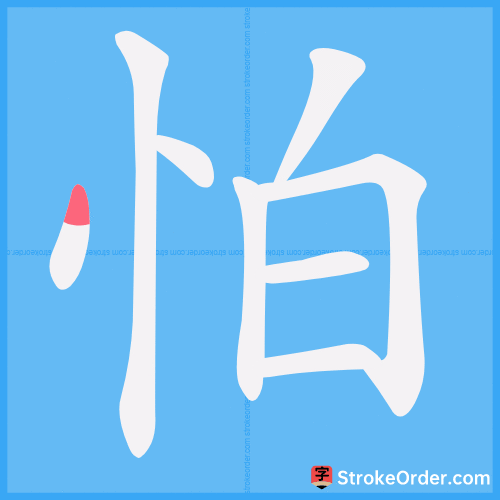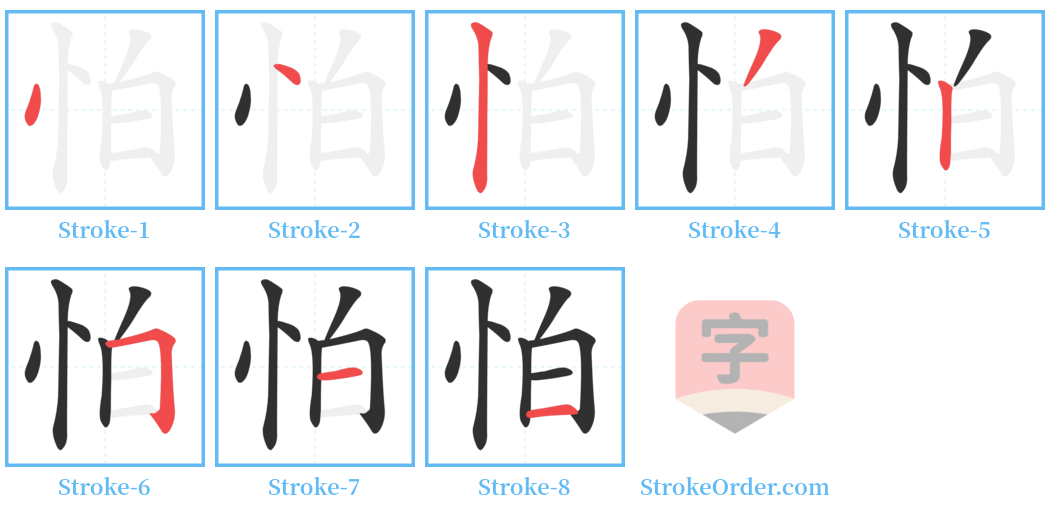怕 Stroke Order
Animated Stroke Order of 怕

Stroke Order Diagrams for 怕

Step-by-Step Handwriting Guide for 怕

Learn to Write Chinese Characters with Video Tutorials
Watch the video of writing the Chinese character "怕", learn the correct stroke order (笔顺) of the character "怕", and master the standard way of writing the character "怕".
Free Printable Handwriting Practice with Stroke Order: 怕
Printable Writing Practice Worksheet of "怕" in Portrait Orientation (Tian Zi Ge)

Printable Writing Practice Worksheet of "怕" in Landscape Orientation (Tian Zi Ge)

Information of 怕
Pinyin
pà
Radical
忄
Strokes
8 strokes
Usage
★★★★★
Definition
to be afraid / to fear
怕 [pà]
Definition:
1. Fear; fright; to be afraid.
2. Perhaps; to express doubt or conjecture.
Meanings:
1. Fear:
- 害怕 (to be afraid of someone)
- 怕死 (to be afraid of dying)
- 害怕 (to be frightened)
- 惧怕 (to fear)
- 可怕 (frightening)
2. Perhaps; expressing doubt or conjecture:
- 恐怕他别有用意 (I’m afraid he has ulterior motives)
- 怕是 (perhaps)
Usage:
1. Used before the predicate or at the beginning of a sentence to estimate or speculate on a situation, expressing doubt or discussion, equivalent to “恐怕” (I’m afraid), “也许” (perhaps), “或许” (maybe); in modern Chinese, it often ends with "吧".
Example:
- 怕是有什么意外,平时他总是准时来的 (I’m afraid there may be some unexpected events; he is usually punctual).
- 怕不 (I’m afraid so, maybe).
- 怕敢 (I’m afraid so, maybe).
2. As; could it be? (岂).
Example:
- 怕不待 (could it not be...?)
3. If (如其; 倘).
Historical References:
1. 《广韵》: 怕,怕惧 (Fear).
2. 韩愈《双鸟诗》: 鬼神怕嘲咏 (Ghosts and deities fear ridicule).
3. 明· 于谦《石灰吟》: 粉骨碎身浑不怕 (Crushed bones, body disintegrated, yet not afraid).
Examples:
- 惧怕 (to be afraid);
- 害怕 (to feel uneasy or panicked when encountering difficulties, dangers, etc.);
- 怕怯 (to fear).
awful / dreadful / fearful / formidable / frightful / scary / hideous / horrible / terrible / terribly
greedy for life, afraid of death (idiom); craven and cowardly / clinging abjectly to life / only interested in saving one's neck
Input Method for 怕
Pinyin
pa4
Wubi
nrg
Cangjie
pha
Zhengma
unk
Four Corner
96002
Unicode
U+6015